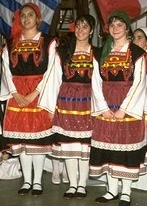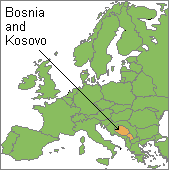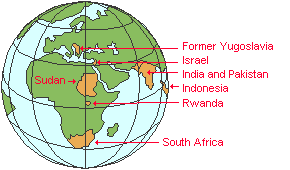Nature
of Ethnicity
| |
|
|
 |
Canadian women
using
clothing to symbolize
their Greek ethnicity |
|
All around the
world, members of ethnic and so-called "racial" groups commonly
use ethnic symbols as badges of identity to emphasize their distinctness from other
groups. Language, religion, and style of dress are common ethnic symbols. In
addition to such cultural traits, biological characteristics may be important at times as
well. The Canadian women shown on the right are using their clothing to strongly communicate
their Greek identity on a special occasion.
 |
|
 |
|
African Americans |
African
American ethnicity is usually defined by dark brown skin color. However, shared
experience and dialect are often as important since the range of skin coloration is quite
broad among African Americans today due to centuries of interbreeding with Europeans,
Native Americans, and, more recently, Asians.
Ethnic group unity needs to
be reinforced by a constant emphasis on what traits set the members apart from others,
rather than what they share in common with the outsiders. This is a universal means of
boundary
maintenance, or defense, between ethnic groups. Ethnic symbols are convenient
markers for making "we-they" distinctions and are the focal points for racism and other unpleasant manifestations of ethnocentrism
 . They also mask in-group
differences. In the United States. for instance, they help propagate the myth that there is a single,
coherent American Indian ethnic group. The same goes for Hispanics,
European Americans, African Americans, Asian Americans, and
Pacific Islanders.
. They also mask in-group
differences. In the United States. for instance, they help propagate the myth that there is a single,
coherent American Indian ethnic group. The same goes for Hispanics,
European Americans, African Americans, Asian Americans, and
Pacific Islanders.
Whether or not individuals
in minority ethnic or "racial" groups prominently emphasize their ethnic symbols
may vary with the situation. They may not emphasize them if they are trying to
identify with or join the dominant culture in their society. That is to say, they
may de-emphasize the things that make them different if they wish to assimilate
 into the dominant ethnic group. For
instance, the children of many immigrants to the United States prefer to speak in the local
colloquial dialect
into the dominant ethnic group. For
instance, the children of many immigrants to the United States prefer to speak in the local
colloquial dialect
 of English rather than in their parents' native language.
Likewise, they choose to dress and act like other Americans in their schools. This
has the effect of making them less different from their neighbors while estranging them
from their parents.
of English rather than in their parents' native language.
Likewise, they choose to dress and act like other Americans in their schools. This
has the effect of making them less different from their neighbors while estranging them
from their parents.
Assimilation can be speeded
up by marriage across ethnic or "racial" boundaries. As intermarriage
becomes common, ethnic/racial differences often are progressively blurred. Not
surprisingly, many ethnic/racial group organizations are opposed to intermarriage--they
see it as a tool of ethnocide
 .
.
The effect of intermarriage
on reducing ethnic group identity can be seen in the reduction of discrimination against
each of the European immigrant group in North America after several generations. In the
case of Jews, discrimination lasted longer but has also reduced dramatically with the
progressive increase in marriage to non-Jews. In the early 1960's, only 6% of
American Jews
married outsiders. By 1985, the rate had grown to nearly 25%. By
the mid 1990's it was
52%. Over these four decades, discriminatory barriers to Jews largely
disappeared. Of course, there were social changes in America that also contributed
to the reduction in institutionalized discrimination.
| |
 |
"Interracial"
marriage |
African Americans have had a
relatively low frequency of intermarriage, though this is beginning to change
also. In
1970, only 2.6% of their marriages were with European Americans. By 1993, the rate
had increased to 12.1%. The number of intermarriages by African American men has
been 3½ times higher than those by African American women. However, the intermarriage rate for
African American women is now growing at a relatively faster rate.
Asian and Latin Americans
have a comparatively high intermarriage rate with other ethnic/racial groups.
Among Asian
Americans, 12% of the men and 25% of the women have intermarried with others, especially
European Americans. The relatively high rate of intermarriage for Asian and Latin
Americans likely is an indication of a lower resistance to assimilation in their
communities and a greater acceptance of them by the dominant European American society. However, assimilation
is not easy or even possible for members of some minority groups since they
are subject to more persistent stereotyping and discrimination. This is generally the case with African
Americans today. Partly in response to this rejection, assimilation has ceased being
a desirable goal of many African Americans.
| |
 |
|
When ethnic differences are strongly emphasized, as in the case of
"black" and "white" Americans today, it inevitably leads to increased
polarization. It also leads to false notions of biological and cultural homogeneity
within these groups. In addition, it results in a selective blindness in looking at
the past. Polarized people easily fall into the trap of justifying an interpretation
of history that favors their own group and demonizes others. This occurred in a
particularly sinister way in Bosnia and Kosovo during the 1990's, after the breakup of Yugoslavia.
Previously peaceful and overtly friendly Muslims, Croats, and Serbs
living there brutally
slaughtered each other to repay perceived past wrongs and
to "ethnically cleanse" the land.
 |
|
Filipino Americans
|
The American mass media and
government historic preoccupation with black/white relations
has tended to make other
smaller ethnic
groups relatively invisible and discounted their concerns. This is ethnic
discrimination by not acknowledging the existence of people and not taking them into
consideration. An example of a largely overlooked ethnic group is the unobtrusive
Filipino population concentrated in Southern California. Few Americans realize that
they are the 2nd largest recent immigrant group in the country.
Forms of
Discrimination
Prejudice
and discrimination based on presumed ethnic/racial differences are universal--they are
found in various forms in all societies. Acts of prejudice range all the way from
benign classification of people to cruel persecution. However, the term racism
has come to be imprecisely applied to all of these behaviors. Kwame Appiah,
a British and Ghanaian scholar of African American issues, has made a useful distinction between
kinds of prejudicial behavior. He uses the term
racialism for the more benign
forms of discrimination such as categorizing people for reference purposes on the basis of age, gender, and
ethnicity/race. He reserves the term racism for
harmful discrimination such as not hiring someone because of their "race."
This distinction will be followed here.
We are all racialists. It is normal to categorize people in
our daily lives based on a number of traits. It can be a useful aid in predicting behavior. For instance,
when you are lost in a strange city, you very likely approach an adult rather than a young
child for help because you surmise that the adult will know more.
Similarly, when you want to take an out-of-town guest to a good traditional
Mexican restaurant, you may ask a Mexican American friend for recommendations. However, when
categorizing leads to behavior that harms another person, it becomes racism.
| |
 |
| Recent hotspots of
severe racism
|
|
No one ethnic/racial group has the monopoly
on racism. Even members of groups that are aggressively discriminated
against by others may think and act in a vicious racist manner. Racism has been a common
element in American history. However, the most pervasive racist acts are not being
carried out in America today. Far from it. Over the last
two decades, they have been in
such places as the former Yugoslavia, Israel, India,
Pakistan, Indonesia, Rwanda, South Africa and Sudan. In all of
these countries, ethnic identities have been strongly emphasized as a government
policy. The result has been the rise of tribalism
 and even genocide
and even genocide
 in some regions. Throughout
history, there have been numerous atrocities carried out in the name of ethnic/racial
purification. If racism and ethnic persecution are indeed as much a part of human
nature as ethnocentrism, we can expect that such atrocities will occur in the future as
well.
in some regions. Throughout
history, there have been numerous atrocities carried out in the name of ethnic/racial
purification. If racism and ethnic persecution are indeed as much a part of human
nature as ethnocentrism, we can expect that such atrocities will occur in the future as
well.
While racism is universal,
its focus usually changes in the transition from Small-scale societies to
large-scale
ones. The smallest societies are almost always
biologically and culturally homogenous without ethnic group distinctions.
In such societies, the target of racism is other societies. Strangers
are often thought of as being not quite human. In contrast, large
societies are often heterogeneous and have many ethnic groups. The targets of
racism are mostly other ethnic groups within the same society. In Italy, for
instance, Northern Italians often look down upon Southern Italians and stereotype
 them as being ignorant, dishonest, and lazy. Southern Italians often view Northern Italians as being impersonal, dull, and not
trustworthy. A similar north-south stereotyping
occurs in China.
them as being ignorant, dishonest, and lazy. Southern Italians often view Northern Italians as being impersonal, dull, and not
trustworthy. A similar north-south stereotyping
occurs in China.
We have seen that prejudice
in human interaction is a universal phenomenon. The results of prejudgment can range
all the way from relatively harmless racialist categorizing to
vicious racist
acts. By strongly emphasizing ethnic symbols for boundary maintenance purposes,
ethnic groups indirectly foster racism which, in turn, can become an effective tool in
preserving and enhancing the distinctness of the groups. However, racism and other
unpleasant products of heightened ethnic identity can also diminish as a result of
increased communication and intermarriage between groups.
This page was last updated on
Wednesday, July 05, 2006.
Copyright © 1997-2006 by Dennis
O'Neil.
All rights reserved.
Illustration credits






